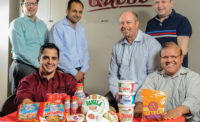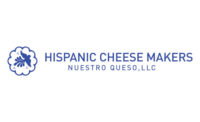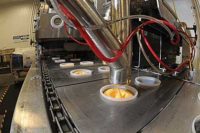Most cheese plants are in small towns, not in major metropolitan areas. That makes sense, because the plants need to be near the milk supply: dairy farms. But Kent, Ill., is really small. The sign at the edge of the town notes the population as “people 72, dogs 52.”
Kent is about 2 ½ hours by car northwest of Chicago and an hour from historic Galena, near the Iowa border. This is where Nuestro Queso, headquartered in Rosemont, Ill., (near O’Hare International Airport) makes cheese.
Nuestro Queso (Spanish for “our cheese”) is a six-year-old business that makes Hispanic cheeses, drinkable yogurts and cultured creams. The full-fat cheeses include asadero, blanco, cotija, duranguense, fresco, panela, para frier and Oaxaca. The cheeses have won awards in the United States Cheese Championship and American Cheese Society contests. The company produces its own brand, makes cheese for private-label customers and sells cheese to food manufacturers to be used in snack foods. (Read the related story, "Nuestro Queso meets the needs of Hispanic buyers on the East Coast and in the Midwest.")
The owners of Nuestro Queso bought a building in Kent that had been used for cheesemaking since the 1940s. It was empty when they took possession of it, so the owners had to outfit it with cheesemaking equipment, including pasteurizers, vats, tables, forms, tunnels, shredders and packaging machinery. This year the company (owned by a group of investors) completed a warehouse addition; the space can be converted to a production area as the company grows.
CEO Mark Braun (one of the investors) is at the plant at least one day a week. One of his first orders of business was to instill a quality-first culture for the approximately 70 employees who work in the plant. Production employees learn good manufacturing practices and know the reasons for them. The culture of quality has paid off in a SQF Level 2 certification. The designation is vital, Braun said. Without it, Nuestro Queso could not go after the private-label business that is so important to the company’s well-being.
“We have some pretty stringent in-process testing that we abide by,” said Plant Manager Jon Nilson. “We have an evaluation of finished goods that we conduct every day.”
The company also tests cheese that has gone out of code to see how it could extend the shelf life, and it simulates conditions at a consumer’s home.
“We try to mimic what could happen in the marketplace,” Nilson said. “We’ll take it in and out [of the refrigerator] . . . and then perform an evaluation. For example, we identify if this vat is having off-flavors. We ask ourselves, ‘Is there something that may put the product at risk?’”
Nilson defined quality as food safety and also functionality and flavor profile.
“We’ve spent a lot of time and effort and money to evaluate both sides. Everything we make here is positively released. No material leaves our possession unless it comes off our stringent testing,” he said.
Employee training
As new employees come on board, they go through a GMP food safety and plant safety process before they even go out onto the floor, Nilson said. That includes educating the hourly employees on the importance of the food safety auditing process.
“We get to tell them why [we follow the practices that we do]. They get to talk about it with other employees. It kind of melds with training. We’re fairly repetitive when it comes to training. That’s how it becomes culture and they drive that. They drive our systems and they drive every area of this plant to be better and that goes for shipping, receiving, everything,” Nilson said.
“There is a significant sense of pride” among the employees, most of whom are Hispanic. Nilson said. “We allow them to take home a bit of cheese every week, and it’s really cool to watch our employees walk out with our cheese and have a sense of pride. They eat what they make and it shows.”
“It’s kind of a whole ‘our cheese’ thing,” Braun added, “that helps foster a feeling of ownership and accountability, too.”
Nuestro Queso cross-trains plant workers “to get more depth,” Nilson said, calling the training “a focal point.”
“I don’t believe that you could walk in a company of our size anywhere in the country and find the diversity in skill sets and the dedication that we have in this plant. It’s pretty cool. In that process of SQF, we had a couple other unforeseen audits that we had to prepare for. Customers specifically wanted this auditing agency to come in and we did them all. We passed them and we got the business. To have that kind of result requires people who are talented and committed to excellence,” he said.
Besides undergoing SQF and customer audits, the plant is inspected regularly by the Illinois Department of Public Health and the federal Food and Drug Administration.
Milk source, receiving and testing
Milk comes from dairy farms in Illinois, Iowa and Wisconsin within a 100-mile radius of the plant. All of the milk the plant buys is Grade A and rBST free.
“The fats and protein of the milk are very strong,” said Nilson, who comes from a cheesemaking family in Vermont. He’s worked at dairies in California and Utah, as well. “This is dairy country and there is a high sense of pride in the Midwest for not only their milk and dairy production and manufacturing, but from a cheesemaking standpoint,” Nilson said.
When a tanker of milk arrives, a milk sample is pulled and tested for antibiotics, fats and solids. Then the contents of the tanker are pumped into one of the four refrigerated raw milk silos. The silo room has a dedicated clean-in-place system. There is a separate CIP system elsewhere in the plant for the cheesemaking equipment.
The milk flows through a high temperature/short time pasteurizer. From there, the milk goes to the double-O cooking vats where cultures, rennet and enzymes are added. As the mixture cooks, cheesemakers are pulling samples and carrying them to the lab to be tested for pH levels and other attributes.
“With cheese, you have raw material, which is whey,” Nilson said. “You make curds and whey, then your whey goes one way. Well, we also do thorough testing on our whey to make sure that we are not getting too much fat or solids in the whey. Because if it’s in the whey, it’s not in the cheese. We prefer it in the cheese. Consistency is the key.”
From the HTST pasteurizer, the milk is pumped to one of two cheesemaking rooms. In the north room, the milk is pumped into a long drain-belt cheesemaking machine. As the cheese mixture flows through the machine, salt is added pneumatically from a nearby salt storage room. After a de-wheying process, the curds are cut by an internal wire and they exit at the other end of the machine.
When Dairy Foodsvisited, the plant was making cotija. When the curd was ready, it was all hands on deck. The curds are pumped into forms and a technician checks the weight, adding or subtracting curds by hand, as needed. The plant makes 20-, 26-, 40-, 53- and 60-pound blocks and rounds. The forms are carried to racks and clamped tight. A pneumatic press squeezes out additional whey as the curds knit together.
In the south room, the cheese is cooked and stretched, then sent through an extruder and into a brine bath. Employees pull these 20-foot-long “ropes” of cheese from the brine, cut them into lengths and braid them by hand. It’s a traditional Mexican presentation.
The cheeses are wrapped in a packing room with HEPA filtration. Packages of blocks, slices, shreds and braids are vacuum-sealed and conveyed through a shrink tunnel to assure a tight fit of plastic against cheese. Automatic labeling machines are on order; but the day Dairy Foodsvisited, the labels were applied by hand. Cheeses pass through a metal detector as they are packaged. After packages are hand-packed into cases, the cases pass through a metal detector, a quality process ensuring double protection.
Packaged cheeses are conveyed by forklifts to the refrigerated warehouse where they wait until samples pass inspection. Finished products are sent to outside labs to be tested for pathogens. The products are on a positive release, meaning they must pass stringent in-house testing as well as pathogen test before they can be trucked to customers.
Starting from scratch
One of the attractions of the building in Kent was that there was no equipment, Braun said. But first the company built new, sanitary-tiled walls and floors. Then the owners wrote an equipment list and went shopping. Two 35,000-gallon double-O cooking vats were the first to arrive. (The plant added two more later.) Then a small drain-belt system was installed but then quickly replaced by a larger and automated drain-belt system.
“We had to buy all the forms for the form cheeses and grinders. It just became more and more progressive. Then we added shred-line capabilities,” Braun recalled.
Two silos came with the plant and Nuestro Queso refrigerated them and bought two more refrigerated silos. All have back-up systems. The cheesemaker can blend in the silos but new equipment that’s on order will eliminate the need to do that.
Braun said he bought the highest-grade of equipment in order to meet USDA standards, even though it incurred higher expenses. “Now, many cheese plants are not USDA. That’s not a requirement, but it’s a standard that we set as a company,” he said. “For example, the stainless steel. It’s got to be 3-A stainless steel [3-A Sanitary Standards Inc. is a not-for-profit group promoting hygienic standards and equipment in food processing]. You could have a lesser grade if you were not USDA. It’s not just that. Every piece of equipment has to comply with USDA.”
Nuestro Queso is only one of four cheese plants in Illinois that is surveyed and approved for the USDA Grading Service. According to the USDA, “Plant managers recognize it as an important means for improving and maintaining a sound operation for producing dairy products that will meet specific grade or contract requirements and that have the uniform quality essential for buyer and consumer approval and protection. Buyers also find this program a reliable guide to sources of dairy products that have been produced under sanitary and wholesome conditions.”
In December 2014, Nuestro Queso completed a dry goods warehouse attached to the plant. That created an additional 12,000 square feet of storage. The company is not done acquiring equipment and improving the plant.
“We are modifying our packaging side, streamlining packaging,” Nilson said.
The company is in research and development on two or three different new items, he said. The items don’t use current packaging, so Nuestro Queso will be buying packaging and cheesemaking equipment for that project. The end result will allow the company to serve the foodservice-institutional ingredient business as well as retail markets.
Learning by doing
To learn about new equipment and new techniques, Nilson said he relies on networking.
“We actually had [experts from the University of Wisconsin] come in and do an analysis of our plant to make sure that everything was up to their standards and they have pretty high standards. It was very successful, helpful, educational,” he said.
Nilson said he did not have any experience making Hispanic cheeses before joining Nuestro Queso.
“There are some techniques that were in place. I said, ‘I don’t know why you do that. It doesn’t make sense to me.’” Then he said he discovered “there were very specific reasons why that was done and that was to maintain specific body textures and flavor profile. Never in 1,000 years would I have figured things out myself,” he admitted.
“So there are some very specific techniques that are required with Hispanic cheeses and particularly fresh Hispanic cheeses that are not what I would consider normal run-of-the-mill cheese making issues. It is more than a recipe. It is a technique.”
This is what cheesemakers mean when they talk about the art and science of making cheese. It’s not just about putting ingredients together. It’s about how they add the ingredients, how long they cook the milk and when they cut the curd.
Braun added, “Our idea of making it from a small batch to commercializing it to this kind of scale, that’s where a lot of the nuances that Jon’s talking about come into play.”
Touring the plant, a belt stopped in one of the cheesemaking rooms and we had to wait two minutes.
Braun noted, “From a book you think, ‘Okay, here’s the recipe and let’s rock and roll with it.’ But that guy up there knew that they had to go through this process. Why? Because [the cheese was made in a different part of the vat]. There are just all these little nuances that are very important.”
Here’s another example of showing the art and science of cheesemaking. The vats hold 35,000 pounds of milk, but when making some cheeses, Nilson doesn’t fill them to capacity.
The reason, he said is that “the variances that happen from the beginning of the vat to the end of the vat can be very significant based on time. To make the highest-quality product that can be made to fit within the Nuestro Queso specifications and standards, we’d rather make fewer, smaller ones than go whole-scale, fill them up and run with them.”
Gesturing with his hands, he explained, “because we don’t want cheese with a variance from here to here [demonstrating a wide gap]. We want cheese with a variance from here to here [showing a small gap].”
Whatever it takes
Nilson said the company owners have been generous. If he needs something for the plant, the owners get it for him.
“I have never gone to them and said, ‘I really need this’ and not gotten what we’ve asked for. Ever. I guess I’m spoiled in that respect but our ownership is absolutely committed to what we are. It’s unbelievable. It allows us not to cut the corners that a lot of [other cheesemakers] will. We’re here for the long term. We don’t want hiccups; we want to focus on quality. We want to have everything in line that is required to produce a quality product and we’re afforded that by our ownership.”
At-A-Glance
Nuestro Queso, Kent, Ill.
- Size of plant: 75,000 square feet
- Products made: Hispanic-style cheeses, including asadero, blanco, cotija, Duranguense (Mennonite-style cheese), fresco, panela, para frier and Oaxaca.
- Formats: Loaves, wheels and shredded cheeses in trays, bags, ropes and pails
- Silos: Four refrigerated raw milk silos
- Pasteurization: Multiple high temperature/short time
- Equipment: Four 35,000-gallon double-0 cooking vats
- Warehouse: 12,000 square feet
Photos by Vito Palmisano












